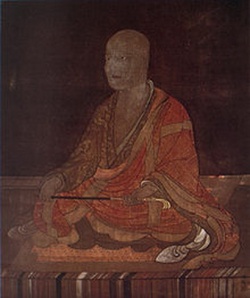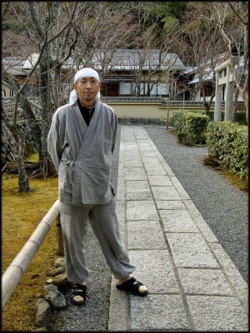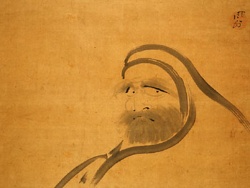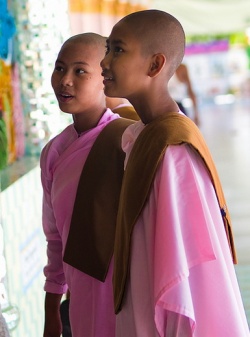Difference between revisions of "Roben"
| (2 intermediate revisions by the same user not shown) | |||
| Line 1: | Line 1: | ||
| − | [[File:Rōben_(Todaiji).jpg|thumb|250px|]] | + | [[File:Rōben_(Todaiji).jpg|thumb|250px|]]<nomobile>{{DisplayImages|2232|847|2814}}</nomobile> |
| Line 7: | Line 7: | ||
'''[[Roben]]''' [[良弁]]; (689–773) | '''[[Roben]]''' [[良弁]]; (689–773) | ||
| − | The [[second patriarch]] of the [[Japanese]] [[Flower Garland]] ([[Kegon]]) | + | The [[second patriarch]] of the [[Japanese]] [[Flower Garland school]] ([[Kegon]]) and the [[first chief priest of Todai-ji temple]] in [[Nara]]. |
| − | He originally studied the teachings of the [[Dharma Characteristics]] ([[Hosso]]) | + | He originally studied the teachings of the [[Dharma Characteristics school]] ([[Hosso]]) under [[Gien]] and lived at [[Konsho-ji]] [[temple]]. |
| − | In 740 he invited [[Shinjo]], who was living at [[Daian-ji temple]] in Nara, to come to Konsho-ji and lecture on the [[Flower Garland Sutra]]. | + | In 740 he invited [[Shinjo]], who was living at [[Daian-ji temple]] in [[Nara]], to come to [[Konsho-ji]] and lecture on the [[Flower Garland Sutra]]. |
| − | Since this was the first lecture on the [[Flower Garland Sutra]] ever given in [[Japan]], Shinjois regarded as the founder of the [[Flower Garland school]] in that country.Roben became his successor. | + | Since this was the first lecture on the [[Flower Garland Sutra]] ever given in [[Japan]], [[Shinjois]] regarded as the founder of the [[Flower Garland school]] in that country.[[Roben]] became his successor. |
Under the {{Wiki|patronage}} of [[Wikipedia:Emperor Shōmu|Emperor Shomu]], he devoted himself to the building of [[Todai-ji temple]]. In 752 he was appointed the temple's first [[chief priest]] and later was given the title [[administrator of priests]]. | Under the {{Wiki|patronage}} of [[Wikipedia:Emperor Shōmu|Emperor Shomu]], he devoted himself to the building of [[Todai-ji temple]]. In 752 he was appointed the temple's first [[chief priest]] and later was given the title [[administrator of priests]]. | ||
| − | [[Rōben]] ( | + | [[Rōben]] ([[良弁]]、[[朗弁]]、[[良辨]]、[[朗辨]]?) (689 – 773), also known as [[Ryōben]], was a [[Japanese Buddhist]] [[monk]] of the [[Kegon sect]], and clerical founder of the [[Tōdai-ji]] [[temple]] in [[Nara]], [[Nara]] Prefecture, [[Japan]]. |
| − | He is popularly known as the " | + | He is popularly known as the "[[Golden Bell Practitioner]]" ([[金鐘行者]] [[Konshō Gyōja]]?). |
His [[life]] spanned the late {{Wiki|Asuka}} period (538 – 710) to the early [[Nara period]] (710 – 794), a period associated with the establishment of [[Buddhism in Japan]]. | His [[life]] spanned the late {{Wiki|Asuka}} period (538 – 710) to the early [[Nara period]] (710 – 794), a period associated with the establishment of [[Buddhism in Japan]]. | ||
| Line 26: | Line 26: | ||
Early [[life]] | Early [[life]] | ||
| − | According to [[tradition]], [[Rōben]] was born either in either Ōmi Province in present-day {{Wiki|Shiga Prefecture}} or [[Sagami]] Province in present-day [[Kanagawa]] Prefecture. [[Sagami]] is considered the more likely location. | + | According to [[tradition]], [[Rōben]] was born either in either [[Ōmi Province]] in present-day {{Wiki|Shiga Prefecture}} or [[Sagami]] Province in present-day [[Kanagawa]] Prefecture. [[Sagami]] is considered the more likely location. |
| − | According to legend as a young baby, [[Rōben]] was snatched by an {{Wiki|eagle}} and dropped off over a pine [[tree]] in front of what is now the Nigatsu-dō Hall. [[Rōben]] was raised as a [[monk]], and reunited with his mother 30 years later. | + | According to legend as a young baby, [[Rōben]] was snatched by an {{Wiki|eagle}} and dropped off over a pine [[tree]] in front of what is now the [[Nigatsu-dō Hall]]. [[Rōben]] was raised as a [[monk]], and reunited with his mother 30 years later. |
In one version of the story, [[Rōben]] wore an [[amulet]] of [[Kannon Bodhisattva]] since he was a baby, which his mother [[recognized]] when she came to Nara as a [[pilgrim]]. | In one version of the story, [[Rōben]] wore an [[amulet]] of [[Kannon Bodhisattva]] since he was a baby, which his mother [[recognized]] when she came to Nara as a [[pilgrim]]. | ||
| Line 54: | Line 54: | ||
[[Rōben]] later presided over the drawing of the [[eyes]] {{Wiki|ceremony}} of the [[Great Buddha]] statue at [[Tōdai-ji]] in 751. | [[Rōben]] later presided over the drawing of the [[eyes]] {{Wiki|ceremony}} of the [[Great Buddha]] statue at [[Tōdai-ji]] in 751. | ||
| − | He was first a bettō [[monk]] at [[Tōdai-ji]], but was later promoted to be a zōshō ([[僧正]]?) high [[Buddhist priest]] of the [[temple]]. | + | He was first a [[bettō]] [[monk]] at [[Tōdai-ji]], but was later promoted to be a zōshō ([[僧正]]?) high [[Buddhist priest]] of the [[temple]]. |
Later [[life]] | Later [[life]] | ||
| − | [[Rōben]] spent the final years of his [[life]] on the establishment of Ishiyama-dera in present-day {{Wiki|Ōtsu, Shiga}} Prefecture. | + | [[Rōben]] spent the final years of his [[life]] on the establishment of [[Ishiyama-dera]] in present-day {{Wiki|Ōtsu, Shiga}} Prefecture. |
| − | He [[died]] on November 16, 773 at the age of 85 at or near Uda in present-day {{Wiki|Nara Prefecture}}. | + | He [[died]] on November 16, 773 at the age of 85 at or near [[Uda]] in present-day {{Wiki|Nara Prefecture}}. |
</poem> | </poem> | ||
{{R}} | {{R}} | ||
Latest revision as of 11:44, 4 January 2016
Roben 良弁; (689–773)
The second patriarch of the Japanese Flower Garland school (Kegon) and the first chief priest of Todai-ji temple in Nara.
He originally studied the teachings of the Dharma Characteristics school (Hosso) under Gien and lived at Konsho-ji temple.
In 740 he invited Shinjo, who was living at Daian-ji temple in Nara, to come to Konsho-ji and lecture on the Flower Garland Sutra.
Since this was the first lecture on the Flower Garland Sutra ever given in Japan, Shinjois regarded as the founder of the Flower Garland school in that country.Roben became his successor.
Under the patronage of Emperor Shomu, he devoted himself to the building of Todai-ji temple. In 752 he was appointed the temple's first chief priest and later was given the title administrator of priests.
Rōben (良弁、朗弁、良辨、朗辨?) (689 – 773), also known as Ryōben, was a Japanese Buddhist monk of the Kegon sect, and clerical founder of the Tōdai-ji temple in Nara, Nara Prefecture, Japan.
He is popularly known as the "Golden Bell Practitioner" (金鐘行者 Konshō Gyōja?).
His life spanned the late Asuka period (538 – 710) to the early Nara period (710 – 794), a period associated with the establishment of Buddhism in Japan.
Early life
According to tradition, Rōben was born either in either Ōmi Province in present-day Shiga Prefecture or Sagami Province in present-day Kanagawa Prefecture. Sagami is considered the more likely location.
According to legend as a young baby, Rōben was snatched by an eagle and dropped off over a pine tree in front of what is now the Nigatsu-dō Hall. Rōben was raised as a monk, and reunited with his mother 30 years later.
In one version of the story, Rōben wore an amulet of Kannon Bodhisattva since he was a baby, which his mother recognized when she came to Nara as a pilgrim.
Records with the Ministry of Justice in Nara at the time, do record Rōben as having been raised as a monk since infancy, but do not state anything further as to his origins.
Early studies
Rōben first studied Hossō Buddhism under the monk Gien (義淵?) (d. 728).
Gien and his disciples Rōben and Gyōgi are considered to have created the foundation of Japanese Buddhism at the beginning of the Nara period.
In 733, the fifth year of the Tenpyō era, Rōben oversaw expansion and construction of Kinshō-ji (金鐘寺?) and the massive bronze statue of Vairocana Buddha under the patronage of Emperor Shōmu (724 – 749).
Kinshō-ji is now the Hokke-dō hall of Tōdai-ji.
Establishment of Kegon school
In 740, the twelfth year of the Tenpyō era, an eminent Korean monk of the Silla kingdom (57 BC – 935 AD) named Simsang (審祥, known as Shinjō in Japan, was invited by Rōben to Japan to help establish a new sect based on the Huayan school of thought.
This led to the foundation of the Kegon school of Buddhism with permission from Emperor Shōmu. Rōben subsequently became the second patriarch of the Kegon school.
Rōben later presided over the drawing of the eyes ceremony of the Great Buddha statue at Tōdai-ji in 751.
He was first a bettō monk at Tōdai-ji, but was later promoted to be a zōshō (僧正?) high Buddhist priest of the temple.
Later life
Rōben spent the final years of his life on the establishment of Ishiyama-dera in present-day Ōtsu, Shiga Prefecture.
He died on November 16, 773 at the age of 85 at or near Uda in present-day Nara Prefecture.



